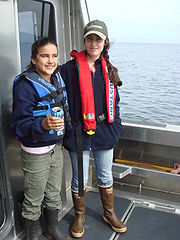
Lifejacket
Encyclopedia

Personal flotation device
A personal flotation device is a device designed to assist a wearer, either conscious or unconscious, to keep afloat.Devices designed and approved by authorities for use by...
designed to keep your airway clear of the water whether the wearer is conscious or unconscious. They can come in two types, inflatable and foam.
The inflatable lifejacket is probably the most widely used for both leisure and commercial activities, while the foam lifejacket is predominantly designed either for children, or for emergency use (such as on ferries, cruise ships etc).
The 100N lifejacket
The 100N lifejacket is for those who may have to wait for rescue but are likely to be in sheltered, calm water. It may not have sufficient buoyancy to protect someone who is unable to help himself or herself and may not roll an unconscious person on to his or her back, particularly someone in heavy clothing.The 150N lifejacket
The 150N lifejacket is for general use on coastal and inshore waters when sailing and fishing. It is intended for general offshore and rough-weather use when a high standard of performance is required. It should turn an unconscious person onto his or her back and requires no subsequent action by the wearer to keep his or her face out of the water. Its performance may be affected if the user is wearing heavy and/or waterproof clothing.The 275N lifejacket
The 275N lifejacket is recommended for offshore cruising, fishing and commercial users. It is intended primarily for extreme conditions and for those wearing heavy protective clothing that may adversely affect the self-righting capacity of other lifejackets. It is designed to ensure that the wearer is floating in the correct position with his or her mouth and nose clear of the surface of the water.Types of inflation
There are four inflation methods for air-only lifejackets. It is important to know which method your lifejacket uses and how it works.Oral
Some older lifejackets had oral inflation as their only method of inflation, normally via a one-way valve. Although intended for oral inflation, a suitable low pressure pump may be used if preferred. These lifejackets should be fully inflated before going afloat, and should be worn fully inflated until the wearer is back ashore. Although it is doubtful whether these are still in production, they may still be found in use. Modern lifejackets, inflated by means of a gas cartridge, usually if not always have oral inflation as well; this is intended for topping up if the casualty is in the water for an extended period while awaiting rescue, but may also be useful for inflating the lifejacket for test purposes to verify the integrity of the bladder.
Manual
Manually inflated lifejackets are operated by pulling a string, which pushes a firing pin into the CO2 canister, inflating the lifejacket. Automatic and hydrostatic lifejackets both have a manual pull string as back up.
Automatic
Automatically inflated lifejackets rely on a small pellet or bobbin, which holds back a powerful spring. When the pellet makes contact with water it dissolves very rapidly, releasing the spring, which pushes a firing pin into the gas canister.
Hydrostatic (Hammar)
Hydrostatic or Hammar action lifejackets work the same way, but the pellet is protected by a case that only lets water in once it is a few centimetres below the surface. It won’t fire until fully submerged.
Choosing a childs lifejacket
All children’s lifejackets state a maximum weight and chest size that must not be exceeded. It is equally important not to buy a lifejacket that is too large, as this may result in the child slipping out of it or the lifejacket floating high in the water leaving the child’s mouth and nose submerged.A good way to tell if a lifejacket is the right size is to fit and adjust it and then lift it from the top. It should not be possible to lift the lifejacket more than 2.5 cm from the child’s shoulders.

